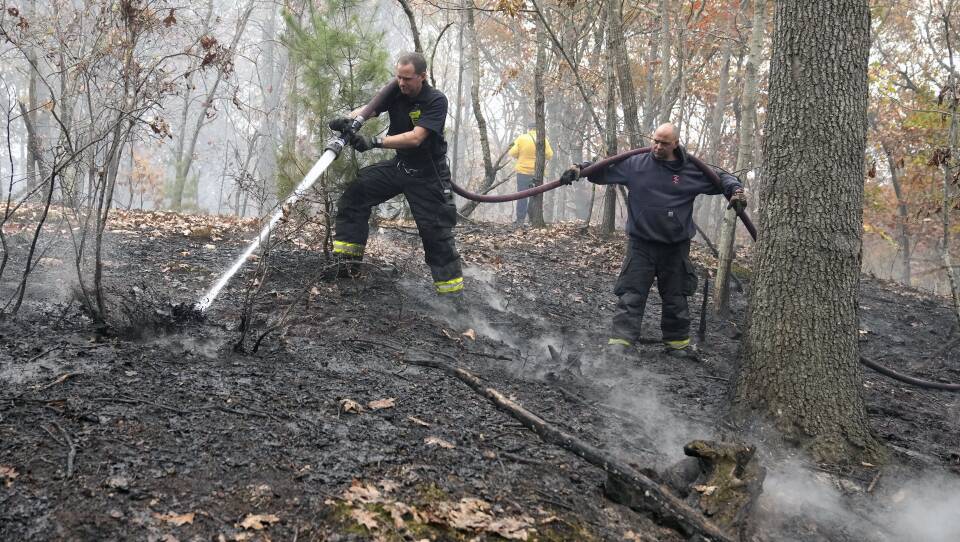Dozens of brush fires continue to burn around Massachusetts, and the weather forecast isn’t offering any help in the coming days.
State officials say as of Sunday night, 87 brush and wildland fires had been reported in the preceding week, which burned about 483 acres.
“We’ve had an abnormally dry fall in Massachusetts, and I guess you could say that the bill has finally come due,” said Jake Wark of the Massachusetts Department of Fire Services. “In the average October, we see about 15 brush and wildland fires in Massachusetts. This year we had more than 200. And unfortunately, November is off to a similar start. We’ve had about 30 fires so far in just the past few days compared to the 20 that we usually see during the entire month.”
Some of the biggest fires over the last week have been in Middleton, where 188 acres have burned near Middleton Pond, and Cain Hill in Salem and Lynn, where 140 acres have burned. A hundred acres have burned in Devens and Montgomery has seen 60 acres burned.
“As we confront an unprecedented fall fire season, I’m asking all our residents to protect themselves, their neighbors, and their communities by refraining from any outdoor activities that involve open flames, sparks and embers, or other heat sources,” Governor Maura Healey said in a written statement. “I especially want to thank the firefighters who have been battling these fires, very often for days at a time and across the state from their homes and families. We have seen truly remarkable efforts from our fire service. Let’s support them by using caution and common sense out there.”
The state’s fire risk is significantly elevated this year as a result of the unusually prolonged period of dry weather.
“Unfortunately ... leaves, dry grass, dead trees, other combustibles -- they’re all very dry and that makes them very receptive to ignition,” Wark said. “In other words, they’ll burn quickly, they’ll burn easily. And if you put a little wind behind it, that fire will just take off.”
That wind was a significant factor last Friday as firefighters fought blazes, said Dave Celino, State Fire Supervisor for the Massachusetts Department of Conservation and Recreation.
“We saw the red flag warning on Friday really came to fruition where we had 20 to 30 mile an hour gusts,” Celino said. “And any fires that got started on the afternoon on Friday really took off with rapid rates of spread. We had structures threatened on a number of fires and it was a dangerous situation.”
And it’s going to take some time to fully extinguish the fires, he said.
“These are drought induced fires,” Celino said. “So, the fire behavior is deep burning into the organic soils, into dead stumps. Dead trees are burning, and they’re going to continue to burn. And it makes it very challenging for firefighters. It’s going to be a long duration effort to get full suppression.”
Celino noted that there’s been no lighting in recent weeks to ignite fires, which means that the fires have been caused by human behavior.
“And one of the common denominator causes is abandoned campfires or debris burning, illegal burning,” he said. “And we cannot stress to the public enough that under these conditions, any open flame outdoors around these fuel types, there’s a pretty good chance that it will cause a fire to escape and ultimately become become a wildfire that demands that response.”
Open burning is prohibited statewide through January.
“Almost all of these fires are preventable and most of them start with activity around the house,” said Wark. “Outdoor cooking and heating, sparks and hot engines from lawn tractors and other power equipment, and smoking materials. So this is really a time to refrain from any activity that involves open flames, sparks and embers or other heat sources outdoors.”
The fires have required an enormous effort from firefighters around the state. The statewide “fire mobilization plan,” which coordinates resources from across local departments across Massachusetts, has been activated more than a dozen times since the beginning of October.
“Over the past week and a half or so, we saw firefighters from down in Stoughton heading up to Middleton, just crisscrossing the state so that so that the firefighters are able to handle this large-scale long-term incident,” Wark said.
Celino praised the efforts of local fire departments.
“You know, a lot of the fires, we’re catching them small, keeping them small, getting them 100% suppressed,” he said. “And so hats off to those folks for really having that success kind of behind the scenes. The problem is, is that, you know, the longer that we go into this, the more large, multi-day, multi-week incidents that we have to manage, the more that the capacity gets get stressed and tested.”
And there’s no immediate relief coming in the form of rain.
“Unfortunately, we don’t see much relief in the next few days,” Wark said. “What we’re all hoping for is a good soaking rain that’s going to help us put out and prevent more of these fires.”
This story includes reporting by GBH’s Hannah Reale.





